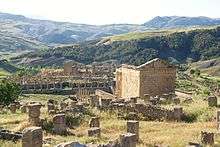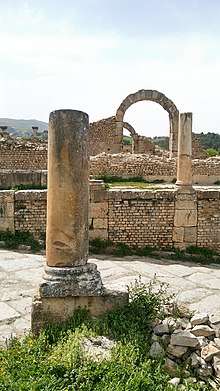Sétif
Sétif is a city in Northeast Algeria.
Understand
The city was part of the ancient Berber kingdom of Numidia, and its name is of Numidian origin; in Berber it means "black" (aseṭṭaf). Under Roman rule, it was named Sitifis, or more officially, Colonia Augusta Nerviana Martialis Veteranorum Sitifensium. From the time of Diocletian, (293 AD), it was the capital of Mauritania Sitifensis province, roughly correspondent to modern eastern Algeria. Today vestiges of the 3rd and 4th century include city walls, temple, circus, mausoleum and "Scipio" Byzantine fortress. Numerous archaeological artifacts are exhibited at its archaeological museum.
The modern city was founded by the French army, who built their own fortress on the site in 1848, using the line of the medieval city wall and the Byzantine fortress.
On 8 May 1945, the day of the formal end of World War II in Europe, an uprising against the occupying French forces in Sétif and the nearby towns Guelma and Kherrata resulted in the deaths of 104 pieds-noirs. The uprising was suppressed through what is now known as the Sétif massacre. Estimates vary widely from 2,000 to 40,000 Algerian casualties.
Get in
By bus
.jpg)
There are several buses connecting the city from Algiers, Constantine, Batna, Ghardaia, Annaba and more, arriving at the 🌍 bus station (Gare Routière de Sétif) (about 2 km southwest from the Ain El Foura fountain). You can take a cab to get to the city centre for about DA 100.
Get around
See
- 🌍 Ain El Fouara Fountain (the city center). The fountain is decorated with sculptures by the French sculptor Francis de Saint-Vidal, and was inaugurated in 1899.
- 🌍 Byzantine citadel, Rue Arab Amar. Its west and south walls are still visible.
- 🌍 Sitifis Roman circus. The ruins of Sitifis' U-shaped Roman circus have now mostly been built over; only the southern curved end remains visible.
Day trip

- 🌍 Djémila, 46 km northeast (bus via El Euelma, 90 min). This very picturesque former Roman town is on the UNESCO World Heritage List. It is possible to walk amongst the ruins and take a close look at the structures. However, there are no signs at the site, so a map or guide will be helpful. Under the name "Cuicul", Djémila was built 900 metres above sea level during the 1st century AD as a Roman military garrison on a narrow triangular plateau in the province of Numidia. Cuicul's builders followed a standard plan with a forum at the center and two main streets, the Cardo Maximus and the Decumanus Maximus, composing the major axes. DA40.

Do
Buy
Eat
- W11 (2 blocks east of the fountain and then turn south). The food is some of the best you will find in Algeria outside of the capital.
Sleep
Most of the hotels are near the city hall. You can find also some cheaper hotels in the nearby city of El Eulma (20 km).
- Ibis and Novotel hotels: the first is 3 stars and the second is 4 stars.
- Four Points by Sheraton, Avenue de L'armee de la Liberation National. Open November 2018.
- Hotel El Mokhtar (Two blocks east of the fountain Ain El Foura). The rooms include air-conditioning, TV, and wi-fi. DA4500 for two beds.
Go next
The city is well-connected by buses to several cities including:
- Algiers — 4 hours
- Constantine — 2 hours. DA200
- Ghardaia — 9 hours including a 30-minutes break. DA950